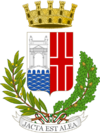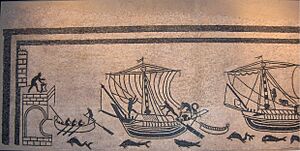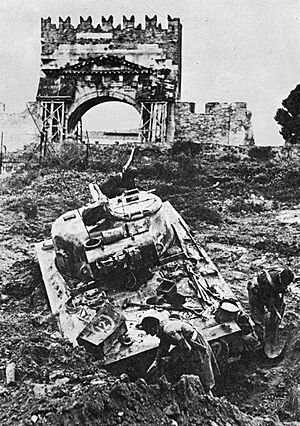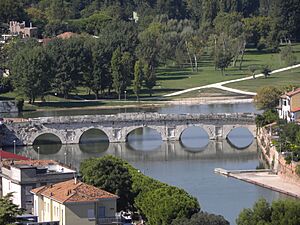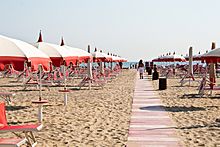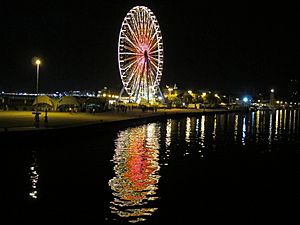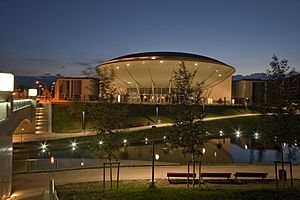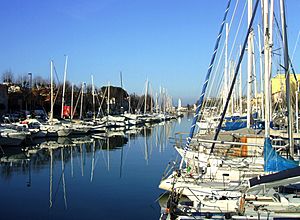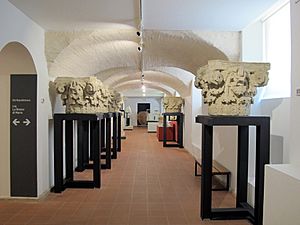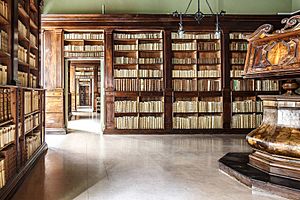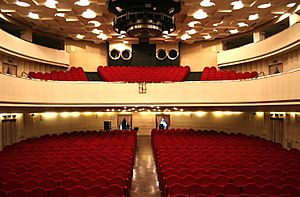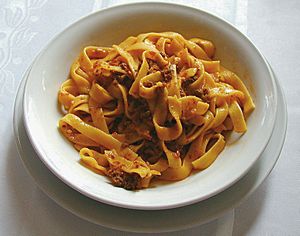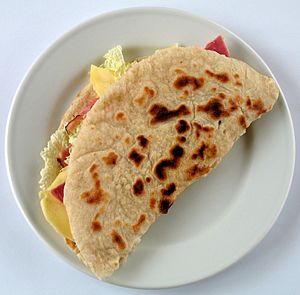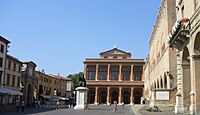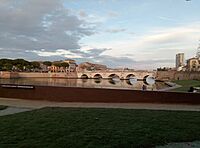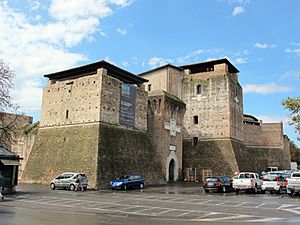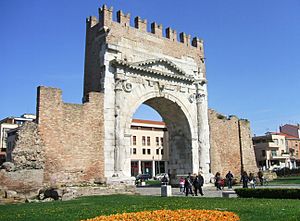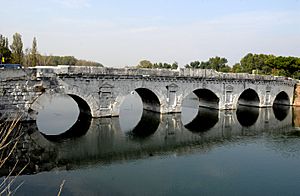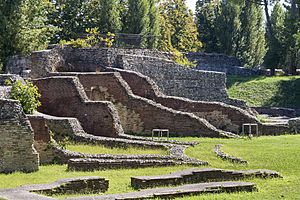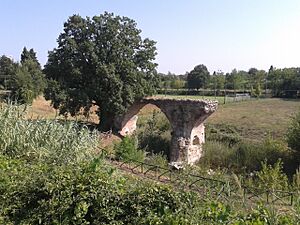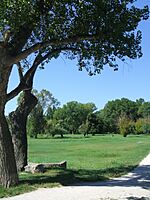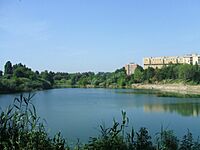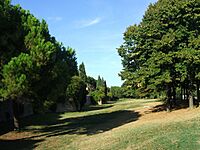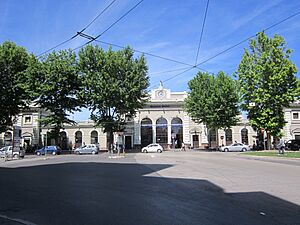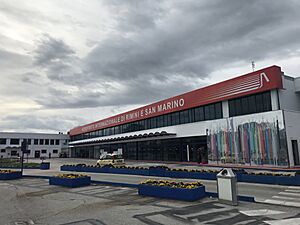Rimini facts for kids
Quick facts for kids
Rimini
Rémin or Rémne (Romagnol)
|
|||
|---|---|---|---|
| Comune di Rimini | |||
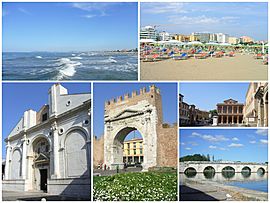
Clockwise from top left: Adriatic Sea and coast of Rimini; Rimini Beach in the Lungomare area; Rimini theatre and Pope Paul V in Cavour Square; Tiberius Bridge; Arch of Augustus; Malatesta Temple
|
|||
|
|||
| Country | Italy | ||
| Region | Emilia-Romagna | ||
| Province | Rimini | ||
| Frazioni | Several, including Miramare and San Vito | ||
| Area | |||
| • Total | 135.79 km2 (52.43 sq mi) | ||
| Elevation | 6 m (20 ft) | ||
| Population
(1 January 2021)
|
|||
| • Total | 148,688 | ||
| • Density | 1,094.98/km2 (2,836.00/sq mi) | ||
| Demonym(s) | Riminese(i) | ||
| Time zone | UTC+1 (CET) | ||
| • Summer (DST) | UTC+2 (CEST) | ||
| Postal code |
47921, 47922, 47923, 47924
|
||
| Dialing code | 0541 | ||
| Patron saint | Gaudentius of Rimini | ||
| Saint day | 14 October | ||
Rimini is a lively city in the Emilia-Romagna region of Northern Italy. It sits right on the Adriatic Sea, making it a super popular beach spot in Europe. People from all over Italy and the world come here for holidays.
Rimini has a long and interesting history. The Romans founded it way back in 268 BC. They built famous landmarks like the Arch of Augustus and the Tiberius Bridge. Later, during the Renaissance, a powerful family called the House of Malatesta ruled the city. They brought famous artists like Leonardo da Vinci to Rimini.
The city is also known as the birthplace of the famous film director Federico Fellini. Plus, it's super close to the tiny independent country of San Marino. Rimini was heavily damaged during World War II, but it was rebuilt and became an even bigger tourist hub. Today, it's also a major center for trade fairs and conferences in Italy.
Contents
- Discovering Rimini's Past
- Rimini's Location and Natural Beauty
- How People Live in Rimini
- Rimini's Economy
- Arts and Culture in Rimini
- Rimini's Look and Landmarks
- Parks and Fun in Rimini
- Learning in Rimini
- Getting Around Rimini
- City Services
- Sports in Rimini
- Famous People from Rimini
- Rimini's Global Connections
- See also
Discovering Rimini's Past
Rimini has a rich history that goes back thousands of years. It has seen many different rulers and big changes.
How Rimini Began
Long ago, the area was home to the Etruscans. Then, the Celts took over around the 6th century BC. In 268 BC, the Roman Republic founded a new city called Ariminum where the Marecchia River meets the sea.
Ariminum was important for stopping Celtic invaders. It also helped the Romans expand into the Po Valley. The city played a role in Roman civil wars, supporting leaders like Julius Caesar. After Caesar crossed the Rubicon river, he spoke to his soldiers in Rimini's main square.
Rimini was a key road junction. The Via Flaminia ended here, connecting central and northern Italy. Other important roads like the Via Aemilia and Via Popilia also started from Rimini. This made it a busy place for trade by land and sea.
You can still see parts of the Roman amphitheater, which could hold 12,000 people. There's also a five-arched bridge, the Tiberius Bridge, built by Emperor Tiberius. These ancient structures show how important Rimini was to the Romans.
Rimini in the Middle Ages

After the Roman Empire, Rimini was taken over by different groups. It was part of the Byzantine Empire for a while. Later, it was given to the Pope. However, Rimini often sided with the emperors during conflicts between popes and Italian cities.
In the 13th century, Rimini became a self-governing city. Many churches and convents were built, attracting famous artists. The "School of Rimini" was a group of artists inspired by the famous painter Giotto.
The House of Malatesta family became very powerful in Rimini. Malatesta da Verucchio took control in 1239. His family ruled Rimini, with some breaks, until 1528. One of the most famous Malatesta lords was Sigismondo Pandolfo Malatesta. He was a skilled general and used his money to make Rimini more beautiful. He had the famous Tempio Malatestiano rebuilt by the architect Leon Battista Alberti.
From Renaissance to Modern Times
After the Malatesta family, Rimini became a smaller town under the Pope's rule. In the 16th century, the main square (now Piazza Cavour) was redesigned. A statue of Pope Paul V was placed there in 1614.
For centuries, Rimini faced challenges like wars, earthquakes, and pirate attacks. Fishing became very important for the city's economy during this time.
In 1797, Napoleon Bonaparte's army came through Rimini. The city became part of the Cisalpine Republic. Napoleon's policies led to the closing of many monasteries and churches.
Rimini's Rise as a Tourist Spot
Rimini started to change in 1843 when the first bathing establishment opened. This was a place where people could go to the beach and enjoy the sea. The Kursaal, a fancy building for social events, became a symbol of Rimini's new role as a tourist resort. The seafront quickly grew with many small villas.
During World War I, Rimini was a target for attacks. Earthquakes in 1916 also caused a lot of damage to the city's buildings and historic churches.
World War II and Rebuilding
World War II hit Rimini very hard. The city was bombed a lot from 1943 until it was freed in September 1944. About 82% of Rimini's buildings were destroyed. Many people had to leave their homes and find shelter in nearby areas or in San Marino.
The Battle of Rimini was a very tough fight during the war. Over 10,000 soldiers died in this battle. Rimini was recognized for its strong resistance against the occupation.
After the war, Rimini began to rebuild. The city focused on growing its tourism industry, which helped it become the popular destination it is today.
Rimini's Location and Natural Beauty
Rimini is located in a special spot on the Adriatic Sea. It's a gateway between northern and central Italy.
Where is Rimini?
Rimini is on the coast of the Adriatic Sea. It's in the southeastern part of Emilia-Romagna. The city is close to the Montefeltro area and the Marche region. Rimini covers about 135 square kilometers. It borders several other towns.
Rimini is the main city in a long coastal area. This area stretches for 50 kilometers and includes many other seaside towns. This long stretch of towns grew as tourism became more popular.
Natural Features of Rimini
Rimini's location is important because it's a natural passage along the Adriatic Sea. It's where the flat lands of the Po Valley meet the more mountainous areas of central Italy. This mix of geography gives Rimini a special climate and beautiful nature.
The Beach
Rimini has a long, sandy beach that is about 15 kilometers (9 miles) long. It can be up to 200 meters (650 feet) wide. The sand is fine, and the sea is shallow, making it great for swimming. The coastline has changed over centuries, with new land being added, especially in the 20th century.
Rivers and Hills
Rimini's city center was built between two rivers: the Marecchia and the Ausa. The Ausa river was moved in the 1960s and 70s to prevent flooding. Its old path was turned into public parks. The Marecchia river was also moved further north to avoid floods. The old riverbed is now Rimini's harbor.
To the southwest, Rimini is surrounded by gentle hills. These hills are covered with vineyards, olive groves, and orchards. You can also find historic villas there.
Rimini's Neighborhoods
Rimini has different parts, each with its own character.
City Center and Old Boroughs
Rimini's old city center is surrounded by ancient walls. In the past, it was divided into four main areas. These areas had different kinds of people and buildings.
Outside the city center were four old boroughs: San Giuliano, San Giovanni, San Andrea, and Marina. These areas became part of the city as it grew.
- Borgo San Giuliano: This area dates back to the 11th century. It was originally a fishing village. Today, it's known for its narrow streets, colorful houses, and frescoes showing characters from Federico Fellini's films.
- Borgo Marina: This area was heavily damaged during World War II because it was close to bridges and the railway station.
Coastal Districts
Rimini's municipality also includes many coastal districts to the north and south of the city center. These areas are famous for their tourist attractions, hotels, and entertainment.
How People Live in Rimini
Rimini is a city with a growing population and a diverse community.
Population Facts
As of 2019, Rimini has about 150,951 people living in it. The population has grown a lot since the first Italian census in 1861, when it was around 28,000.
Tourism has played a big role in Rimini's population growth. Between 1951 and 1981, the city's population jumped from 77,000 to over 128,000.
Many people from other countries live in Rimini, making up about 12.5% of the total population. They come mainly from Eastern Europe, East Asia, and North Africa.
Religion in Rimini
Most people in Rimini are Catholic. The city is home to the Diocese of Rimini. The main church, the Tempio Malatestiano, became Rimini's cathedral in 1809.
Besides Catholic churches, there are also Orthodox, Evangelical, and Adventist churches. Rimini also had a thriving Jewish community in the past.
Rimini's Economy
Rimini's economy is mostly based on tourism, but it also has other important industries.
Tourism: Rimini's Main Business
Rimini is a huge international tourist spot. It's one of the most famous beach resorts in Europe and the Mediterranean. This is thanks to its long sandy beach, many bathing spots, theme parks, and fun activities. Tourism started growing in Rimini in the mid-1800s and really took off after World War II. In 2017, over 57 million tourists visited the city!
The first bathing establishment in Rimini opened in 1843. It was the oldest on the Adriatic Sea. Rimini became a popular place for rich Italian and European families. They loved its wide beach, gentle sea, fancy hotels, and mild climate.
Tourism in Rimini began as a place for health treatments. Later, it became a luxury vacation spot. During the Fascist era, it became popular for middle-class families. After the war, it became a place for everyone.
One fun event is the annual Notte rosa (Pink Night). This is a cultural festival held in early July with concerts and fireworks. It attracts millions of visitors. Rimini also has two of Italy's oldest theme parks: Fiabilandia (opened 1965) and Italia in Miniatura (opened 1970).
Rimini has over 1,000 hotels, with many open all year. Besides beach holidays, Rimini offers events, nightlife, culture, and great food.
Trade Fairs and Conventions
Rimini is a top place in Italy for trade fairs and conferences. The Rimini Fiera has sixteen halls for exhibits, sports events, and music. It also hosts the annual Rimini Meeting, a big religious and cultural festival. Many hotels open especially for these conferences, bringing visitors to Rimini even outside the summer beach season.
Other Important Industries
Other parts of Rimini's economy, like services and construction, have grown because of tourism. Commerce is a big sector, with many shops and stores. Industry is smaller but includes food, woodworking machines, and clothing. Famous companies like Bimota (motorcycles) are based here.
Before the 20th century, agriculture and fishing were Rimini's main jobs. Today, farmers grow crops like wheat, grapes, and olives. Rimini is known for its wine and extra virgin olive oil. The fishing industry is still active, with about 100 fishing boats.
Arts and Culture in Rimini
Rimini has a rich cultural scene with museums, libraries, and a strong connection to film and music.
Museums to Explore
The City Museum
The City Museum (Museo della Città) is Rimini's main and oldest museum. It started in 1872 as an archaeology gallery. It has many ancient Roman items found in Rimini. In 1990, it moved to a large Jesuit convent built in 1749.
The museum's archaeology section shows items from ancient tombs. It also has Roman sculptures, mosaics, and coins. A special exhibit is a medical kit from a Roman doctor's house. The Roman Lapidary, in the courtyard, displays old tombstones and inscriptions.
The art sections have paintings and sculptures from the 14th to 19th centuries. These include works by artists from Rimini and other Italian regions. The City Museum also holds special exhibitions and helps study and restore Rimini's historical art.
Other Interesting Museums
- Fellini Museum: This museum is dedicated to Federico Fellini, the famous film director born in Rimini. It shows drawings, sets, and costumes from his films.
- Museum of Glances (Museo degli Sguardi): This museum focuses on cultures from Africa, Oceania, and the Americas before Columbus. It has over 600 works on display.
- Maritime and Small Fishing Museum: Located in Viserbella, this museum tells the story of Rimini's sea history. It has boats, fishing tools, and a large collection of seashells.
- Multimedia Archaeological Museum: This museum is under the Amintore Galli Theatre. It shows Roman and Byzantine finds discovered during the theater's renovation.
Libraries and Books
The Biblioteca Civica Gambalunga is a historic library founded in 1619. It has over 300,000 books and other items. Some notable items include an 11th-century Evangeliary (a book of Gospels) and old letters.
Theater and Film
Rimini's first theater was created in 1681. The famous Amintore Galli Theatre was built between 1842 and 1857. It's a beautiful neoclassical building. In 1857, it hosted the first performance of Giuseppe Verdi's opera Aroldo. The theater was badly damaged in World War II. After a big restoration, it reopened in 2018.
Rimini has appeared in many films. Federico Fellini, who grew up in Rimini, often showed his hometown in his movies. Films like I Vitelloni and Amarcord (which won an Oscar!) were inspired by Rimini.
Music Scene
Rimini has a long musical history. The composer Guillaume Dufay stayed at the Malatesta court in the 1400s. Later, violinist and composer Carlo Tessarini was born in Rimini in 1690.
In recent years, Rimini has inspired famous musicians. The city is mentioned in songs by Italian artists like Fabrizio De André and Francesco Guccini. Singer-songwriter Samuele Bersani was also born in Rimini.
Delicious Rimini Food
Rimini's food is simple but full of flavor. It's based on the traditions of the countryside, with influences from the sea and hills.
The most common first course is pasta. Many pasta dishes are made with "sfoglia," a dough of eggs and flour rolled by hand. Popular pasta dishes include cappelletti and passatelli in broth, lasagne, and tagliatelle. They are often served with bolognese sauce.
For main courses, you can find meat dishes like chicken or rabbit. There are also many fish dishes, like grilled mackerel and fried squid.
Piada is a famous flatbread from Rimini. It's thin and crispy, made from flour, water, lard, and salt. It's often eaten with grilled meats, cheeses, or vegetables. Cassoni are similar to piada but are stuffed with different fillings.
Popular desserts include ciambella (a ring-shaped cake) and zuppa inglese (a rich dessert with custard). A special sweet bread called piada dei morti is traditionally eaten in November.
Rimini is also known for its local products like squacquerone (a fresh cheese) and saba (a grape syrup). The area produces excellent extra virgin olive oil and wines like Sangiovese and Trebbiano.
Rimini's Look and Landmarks
Rimini's buildings and monuments show its long history, from Roman times to modern days.
Architecture Styles
Rimini has many different kinds of historical buildings. These include churches, palaces, and ancient Roman sites. They show how different civilizations and rulers have shaped the city.
The city has important examples of Roman architecture, like the Arch of Augustus and the Tiberius Bridge. From the Middle Ages, there's the Palazzo dell'Arengo and Castel Sismondo. The Tempio Malatestiano is a masterpiece from the Renaissance.
Rimini's city center still has its Roman layout, but it has changed over time. Earthquakes and wars, especially World War II, caused a lot of damage. However, the city has been rebuilt and restored to highlight its historic places.
Main Sights to See
Religious Buildings
- Tempio Malatestiano: This was originally a Gothic cathedral from the 13th century. It was rebuilt into a Renaissance masterpiece by Leon Battista Alberti for Sigismondo Pandolfo Malatesta. You can find the tombs of Sigismondo and his wife inside.
- Sant'Agostino: A Romanesque church from the 13th century.
- San Fortunato: This church from 1418 has a painting called Adoration of the Magi by Giorgio Vasari.
- San Giuliano Martire: This church, built between 1553 and 1575, has a painting by Paul Veronese.
Important Buildings
- Castel Sismondo: This castle was built by Sigismondo Pandolfo Malatesta. It was later used as a prison.
- Grand Hotel Rimini: Built in the beautiful Art Nouveau style, this hotel opened in 1908. It's famous for its elegance and its connection to film director Fellini. He often stayed here, and a copy of the hotel was featured in his film Amarcord.
- Palazzo dell'Arengo (1204): This building was where the city's government and courts met.
- Amintore Galli Theatre: Opened in 1857, this theater was designed by Luigi Poletti. It was badly damaged in World War II but reopened in 2018 after a full restoration.
Famous Monuments
- Arch of Augustus:
Built in 27 BC to honor Emperor Augustus, this arch marks the end of the Via Flaminia road. It's one of Rimini's most famous symbols and is on the city's coat of arms. It's the oldest preserved arch in Italy.
- Ponte di Tiberio:
This bridge was built between 14 and 21 AD under Emperors Augustus and Tiberius. It crosses the Marecchia River and is known for its impressive Roman design. Many famous artists have painted it.
- Porta Montanara:
This ancient Roman city gate was built in the 1st century BC. It was damaged during World War II. The remaining arch was moved and then restored near its original spot in 2004.
- Fontana dei Quattro Cavalli: This fountain, built in 1928, is a symbol of Rimini as a beach resort. It has a large basin with four horse statues.
- Torre dell'Orologio: This clock tower was built in 1547. It has a clock from 1562 and a calendar from 1750 with zodiac signs.
Fun Attractions
- Italia in Miniatura (in Viserba):
Opened in 1970, this is Italy's fourth-oldest theme park. It has 273 miniature models of Italian and European landmarks. You can even take a gondola ride through a tiny Venice! The park also has a driving school, a monorail, and science exhibits.
Ancient Sites
- Roman amphitheater:
Built in the 2nd century, this amphitheater could hold up to 15,000 people. You can still see its ruins near the coast.
- Ponte di San Vito (in San Vito):
This bridge dates back to Emperor Augustus. Only a 14th-century arch remains of the original Roman bridge. Some historians believe this is where Julius Caesar crossed the Rubicon.
Parks and Fun in Rimini
Rimini has many green spaces for relaxation and activities.
The city has over 1.3 million square meters of parks and gardens. These include large urban parks along old riverbeds, neighborhood parks, and tree-lined streets.
Some of the main parks are XXV Aprile Park, Giovanni Paolo II Park, and Federico Fellini Park. Every Saturday, XXV Aprile Park hosts a parkrun, which is a free, timed 5k run.
Rimini has about 42,000 public trees, with many different types like lime, maple, and pine trees. Some old trees are protected as "monumental trees."
The city has a great network of cycling paths. These paths connect monuments, tourist spots, and beaches. You can use them for city travel, mountain biking, or just enjoying a bike ride.
Learning in Rimini
Rimini is home to a campus of the University of Bologna. About 5,800 students attend classes here in subjects like Economics, Pharmacy, and Sport Sciences.
The city also has many public schools at all levels. This includes nurseries, kindergartens, primary schools, and high schools. The oldest high school, the "Giulio Cesare" Classical Lyceum, was founded in 1800. Famous people like Federico Fellini attended this school.
Getting Around Rimini
Rimini is an important transport hub because of its location. It connects coastal routes with routes that go inland.
Roads for Travel
Rimini is the end point of three ancient Roman roads. Modern roads follow these same paths.
- The SS9 goes from Rimini northwest to San Donato Milanese.
- The SS16 runs along the Adriatic Sea.
- The SS72 connects Rimini to the border with San Marino.
The A14 Adriatic motorway also passes through Rimini. It has two exits in the city: Rimini North and Rimini Sud.
Train Travel
Rimini railway station is a busy train station. It's on the main line between Bologna and Ancona. Regional and national trains stop here.
Rimini also used to have two other train lines that are now closed. One went to Novafeltria, and another connected Rimini to San Marino. There's interest in reopening the line to San Marino.
Rimini has four smaller train stations for regional trains. These include Torre Pedrera, Viserba, Rimini Fiera, and Rimini Miramare.
Air Travel
The city is served by Rimini Fellini Airport, located in the Miramare area. This airport is very important for tourism in Rimini. It's especially popular with tourists from Eastern Europe.
The airport also has a military history. It was once home to an Italian Air Force unit and even stored nuclear bombs during the Cold War. Today, military helicopters are still based there.
Other nearby airports include Forlì, Ancona, and Bologna. There's a bus service that connects Rimini to Bologna Airport.
Buses and Coaches
Rimini and Riccione have a combined bus network. It includes local lines that serve the city and lines that connect to nearby towns.
Rimini also has a trolleybus system with two lines. These lines connect Rimini and Riccione. Route 11 runs along the main seafront. The newer line, Metromare, is a special bus rapid transit line that runs on its own track. It connects Rimini's train station to Riccione's, stopping at places like Fiabilandia and the airport.
Rimini is also a stop for long-distance buses like FlixBus. Local companies offer coach services to other Italian cities and nearby historic sites.
City Services
HERA Group provides gas, water, energy, and waste management services for Rimini.
Rimini has three special stations for waste sorting. The city also has a large wastewater treatment plant that serves many towns, including San Marino.
To protect its beaches, Rimini has a plan to reduce sewage discharges into the sea. This includes building large tanks to collect rainwater.
Sports in Rimini
Rimini has a strong sports scene with popular teams and events.
The main football team is Rimini Calcio. They have played in Italy's second-highest football division.
Rimini also has a notable basketball team, the Basket Rimini Crabs. They have played in Italy's top league and in European competitions. The Rimini Baseball Club has won many national championships and European titles.
Every Easter weekend, Rimini hosts Paganello, a beach ultimate tournament. It started in 1991 and attracts many teams and athletes to the beach. There are two competitions: a Frisbee tournament and a more acrobatic Freestyle event.
Famous People from Rimini
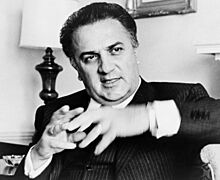
Many notable people have come from Rimini or have strong connections to the city.
- Federico Fellini (1920–1993), a world-famous film director.
- Enea Bastianini (born 1997), a motorcycle racer.
- Samuele Bersani (born 1970), a singer-songwriter.
- Marco Bezzecchi (born 1998), another motorcycle racer.
- Amintore Galli (1845–1919), a music publisher and composer who lived and died in Rimini.
- Carlton Myers (born 1971), a basketball player.
- Hugo Pratt (1927–1995), a famous comic book creator.
- Alessandra Perilli (born 1988), a shooter who won the first Olympic medal for San Marino.
Rimini's Global Connections
Rimini is twinned with several cities around the world, building friendships and cultural exchanges.
Sister Cities
Rimini is twinned with:
 Fort Lauderdale, U.S.
Fort Lauderdale, U.S. Saint-Maur-des-Fossés, France
Saint-Maur-des-Fossés, France Seraing, Belgium
Seraing, Belgium Sochi, Russia
Sochi, Russia Yangzhou, China
Yangzhou, China Ziguinchor, Senegal
Ziguinchor, Senegal
See also
 In Spanish: Rímini para niños
In Spanish: Rímini para niños



